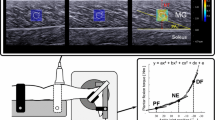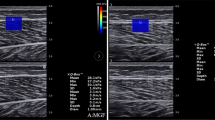Abstract
Purpose
Estimation of muscle passive force from elasticity using shear wave elastography (SWE) has been reported. However, the relationship between the elasticity and passive force of human muscles has not been elucidated. This study investigated the elastic modulus–passive force relationship in human skeletal muscles at multiple sites.
Methods
Four rectus femoris (RF) muscles were dissected from a human Thiel-embalmed cadaver. Calibration weights (0–600 g in 60-g increments) were applied to the distal tendon via a pulley system, and the shear elastic modulus as an index of elasticity was measured using SWE. The shear elastic modulus of the RF was measured at the proximal, central, and distal portions.
Results
The results demonstrated that the relationships between the elasticity in the longitudinal direction of the muscle and the passive force were nearly linear for all tested sites, with coefficients of determination ranging from 0.813 to 0.993.
Conclusion
Shear wave elastography may be used as an indirect method to measure the changing passive force at any site within human muscles.





Similar content being viewed by others
Data availability
The datasets during and/or analysed during the current study available from the corresponding author on reasonable request.
Code availability
Not applicable.
References
Shinohara M, Sabra K, Gennisson J-L, et al. Real-time visualization of muscle stiffness distribution with ultrasound shear wave imaging during muscle contraction. Muscle Nerve. 2010;42:438–41.
Koo TK, Guo J-Y, Cohen JH, et al. Relationship between shear elastic modulus and passive muscle force: an ex-vivo study. J Biomech. 2013;46:2053–9.
Liu J, Qian Z, Wang K, et al. Non-invasive quantitative assessment of muscle force based on ultrasonic shear wave elastography. Ultrasound Med Biol. 2019;45:440–51.
LeSant G, Ates F, Brasseur JL, et al. Elastography study of hamstring behaviors during passive stretching. PLoS ONE. 2015;10:e0139272.
Taniguchi K, Shinohara M, Nozaki S, et al. Acute decrease in the stiffness of resting muscle belly due to static stretching. Scand J Med Sci Sports. 2015;25:32–40.
Le Sant G, Nordez A, Andrade R, et al. Stiffness mapping of lower leg muscles during passive dorsiflexion. J Anat. 2017;230:639–50.
Mathewson MA, Kwan A, Eng CM, et al. Comparison of rotator cuff muscle architecture between humans and other selected vertebrate species. J Exp Biol. 2014;217:261–73.
Ogihara N, Oishi M, Kanai R, et al. Muscle architectural properties in the common marmoset (Callithrix jacchus). Primates. 2017;58:461–72.
Hasselman CT, Best TM, Hughes C, et al. An explanation for various rectus femoris strain injuries using previously undescribed muscle architecture. Am J Sports Med. 1995;23:493–9.
Watanabe K, Kouzaki M, Moritani T. Task-dependent spatial distribution of neural activation pattern in human rectus femoris muscle. J Electromyogr Kinesiol. 2012;22:251–8.
Watanabe K, Kouzaki M, Moritani T. Non-uniform surface electromyographic responses to change in joint angle within rectus femoris muscle. Muscle Nerve. 2014;50:794–802.
Cross TM, Gibbs N, Houang MT, et al. Acute quadriceps muscle strains. Am J Sports Med. 2004;32:710–9.
Pasta G, Nanni G, Molini L, et al. Sonography of the quadriceps muscle: examination technique, normal anatomy, and traumatic lesions. J Ultrasound. 2010;13:76–84.
Fousekis K, Tsepis E, Poulmedis P, et al. Intrinsic risk factors of non-contact quadriceps and hamstring strains in soccer: a prospective study of 100 professional players. Br J Sports Med. 2010;45:709–14.
Thiel W. The preservation of the whole corpse with natural color. Ann Anat. 1992;174:185–95.
Hohmann E, Keough N, Glatt V, et al. The mechanical properties of fresh versus fresh/frozen and preserved (Thiel and Formalin) long head of biceps tendons: a cadaveric investigation. Ann Anat. 2019;221:186–91.
Iida N, Taniguchi K, Watanabe K, et al. Relationship between shear modulus and passive tension of the posterior shoulder capsule using ultrasound shear wave elastography: a cadaveric study. J Biomech. 2020;99:109498–502.
Royer D, Gennisson JL, Deffieux T, et al. On the elasticity of transverse isotropic soft tissues (L). J Acoust Soc Am. 2011;129:2757–60.
Koo TK, Li MY. A guideline of selecting and reporting intraclass correlation coefficients for reliability research. J Chiropr Med. 2016;15:155–63.
Maïsetti O, Hug F, Bouillard K, et al. Characterization of passive elastic properties of the human medial gastrocnemius muscle belly using supersonic shear imaging. J Biomech. 2012;45:978–84.
Eby SF, Song P, Chen S, et al. Validation of shear wave elastography in skeletal muscle. J Biomech. 2013;46:2381–7.
Chino K, Kawakami Y, Takahashi H. Tissue elasticity of in vivo skeletal muscles measured in the transverse and longitudinal planes using shear wave elastography. Clin Physiol Funct Imaging. 2017;37:394–9.
Akagi R, Takahashi H. Acute effect of static stretching on hardness of the gastrocnemius muscle. Med Sci Sports Exerc. 2013;45:1348–54.
Alfuraih AM, O’Connor P, Tan AL, Wakefield RJ, et al. An investigation into the variability between different shear wave elastography systems in muscle. Med Ultrason. 2017;19:392–400.
Hirata K, Yamadera R, Akagi R. Associations between range of motion and tissue stiffness in young and older people. Med Sci Sports Exerc. 2020;52(10):2179–88.
Avrillon S, Lacourpaille L, Hug F, et al. Hamstring muscle elasticity differs in specialized high-performance athletes. Scand J Med Sci Sports. 2020;30:83–91.
Koo TK, Guo J-Y, Cohen JH, et al. Quantifying the passive stretching response of human tibialis anterior muscle using shear wave elastography. Clin Biomech. 2014;29:33–9.
Vachutka J, Sedlackova Z, Furst T, et al. Evaluation of the effect of tissue compression on the results of shear wave elastography measurements. Ultrason Imag. 2018;40:380–93.
Joy J, McLeod G, Lee N, et al. Quantitative assessment of Thiel soft-embalmed human cadavers using shear wave elastography. Ann Anat. 2015;202:52–6.
Yoshitake Y, Miyamoto N, Taniguchi K, et al. The skin acts to maintain muscle shear modulus. Ultrasound Med Biol. 2016;42:674–82.
Koo TK, Hug F. Factors that influence muscle shear modulus during passive stretch. J Biomech. 2015;48:3539–42.
Chino K, Takahashi H. Association of gastrocnemius muscle stiffness with passive ankle joint stiffness and sex-related difference in the joint stiffness. J Appl Biomech. 2018;34:169–74.
Lieber RL, Fazeli BM, Botte MJ. Architecture of selected wrist flexor and extensor muscles. J Hand Surg Am. 1990;15:244–50.
Lieber RL, Ward SR. Skeletal muscle design to meet functional demands. Philos Trans R Soc Lond B Biol Sci. 2011;366:1466–76.
Acknowledgements
This work was supported by JSPS KAKENHI Grant number JP 18K10715.
Funding
This work was supported by JSPS KAKENHI Grant number JP 18K10715.
Author information
Authors and Affiliations
Contributions
TK and KT conceived and designed the study. YY, KW, MF, and MK were involved in the research design. TK, KT, TK, SM, and MF conducted the experiments. TK, KT, and TK analyzed the data. The first draft of the manuscript was written by TK. All authors read and approved the manuscript.
Corresponding author
Ethics declarations
Conflict of interest
None of the authors have any conflicts of interest to disclose.
Ethical statements
All experimental protocols were approved by the Medical Research Ethics Committee at Sapporo Medical University (Approval number: 30-2-26).
Ethics approval
All experimental protocols were approved by the Medical Research Ethics Committee at Sapporo Medical University (Approval number: 30–2-26).
Consent for publication
Not applicable.
Additional information
Publisher's Note
Springer Nature remains neutral with regard to jurisdictional claims in published maps and institutional affiliations.
About this article
Cite this article
Kodesho, T., Taniguchi, K., Kato, T. et al. Relationship between shear elastic modulus and passive force of the human rectus femoris at multiple sites: a Thiel soft-embalmed cadaver study. J Med Ultrasonics 48, 115–121 (2021). https://doi.org/10.1007/s10396-020-01076-w
Received:
Accepted:
Published:
Issue Date:
DOI: https://doi.org/10.1007/s10396-020-01076-w




